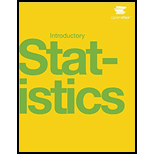
Concept explainers
Use the following information to answer the next two exercises. The cost of a leading liquid laundry detergent in different
sizes is given in Table 12.31.
| Size (ounces) | Cost ($) | Cost per ounce |
| 16 | 3.99 | |
| 32 | 4.99 | |
| 64 | 5.99 | |
| 200 | 10.99 |
Table 12.31
80.
a. Using “size” as the independent variable and “cost” as the dependent variable, draw a
b. Does it appear from inspection that there is a relationship between the variables? Why or why not?
c. Calculate the least-squares line. Put the equation in the form of: y = a + bx
d. Find the
e. If the laundry detergent were sold in a 40-ounce size, find the estimated cost.
f. If the laundry detergent were sold in a 90-ounce size, find the estimated cost.
g. Does it appear that a line is the best way to fit the data? Why or why not?
h. Are there any outliers in the given data?
i. Is the least-squares line valid for predicting what a 300-ounce size of the laundry detergent would you cost? Why
or why not?
j. What is the slope of the least-squares (best-fit) line? Interpret the slope.
Want to see the full answer?
Check out a sample textbook solution
Chapter 12 Solutions
Introductory Statistics
Additional Math Textbook Solutions
Thinking Mathematically (6th Edition)
Introductory Statistics
Calculus: Early Transcendentals (2nd Edition)
Elementary Statistics (13th Edition)
Intro Stats, Books a la Carte Edition (5th Edition)
- Business Discussarrow_forwardThe following data represent total ventilation measured in liters of air per minute per square meter of body area for two independent (and randomly chosen) samples. Analyze these data using the appropriate non-parametric hypothesis testarrow_forwardeach column represents before & after measurements on the same individual. Analyze with the appropriate non-parametric hypothesis test for a paired design.arrow_forward
- Should you be confident in applying your regression equation to estimate the heart rate of a python at 35°C? Why or why not?arrow_forwardGiven your fitted regression line, what would be the residual for snake #5 (10 C)?arrow_forwardCalculate the 95% confidence interval around your estimate of r using Fisher’s z-transformation. In your final answer, make sure to back-transform to the original units.arrow_forward
 Glencoe Algebra 1, Student Edition, 9780079039897...AlgebraISBN:9780079039897Author:CarterPublisher:McGraw Hill
Glencoe Algebra 1, Student Edition, 9780079039897...AlgebraISBN:9780079039897Author:CarterPublisher:McGraw Hill Functions and Change: A Modeling Approach to Coll...AlgebraISBN:9781337111348Author:Bruce Crauder, Benny Evans, Alan NoellPublisher:Cengage Learning
Functions and Change: A Modeling Approach to Coll...AlgebraISBN:9781337111348Author:Bruce Crauder, Benny Evans, Alan NoellPublisher:Cengage Learning Holt Mcdougal Larson Pre-algebra: Student Edition...AlgebraISBN:9780547587776Author:HOLT MCDOUGALPublisher:HOLT MCDOUGAL
Holt Mcdougal Larson Pre-algebra: Student Edition...AlgebraISBN:9780547587776Author:HOLT MCDOUGALPublisher:HOLT MCDOUGAL Big Ideas Math A Bridge To Success Algebra 1: Stu...AlgebraISBN:9781680331141Author:HOUGHTON MIFFLIN HARCOURTPublisher:Houghton Mifflin Harcourt
Big Ideas Math A Bridge To Success Algebra 1: Stu...AlgebraISBN:9781680331141Author:HOUGHTON MIFFLIN HARCOURTPublisher:Houghton Mifflin Harcourt
 Trigonometry (MindTap Course List)TrigonometryISBN:9781337278461Author:Ron LarsonPublisher:Cengage Learning
Trigonometry (MindTap Course List)TrigonometryISBN:9781337278461Author:Ron LarsonPublisher:Cengage Learning





